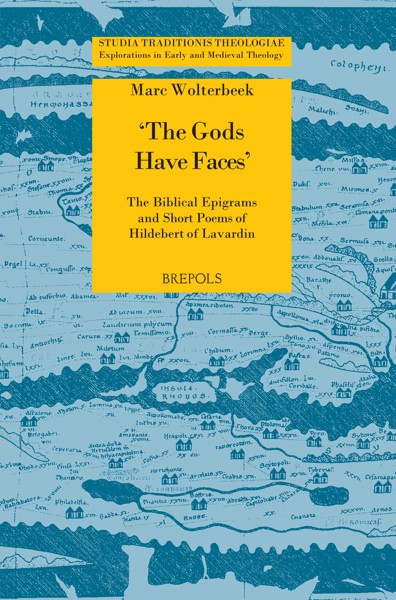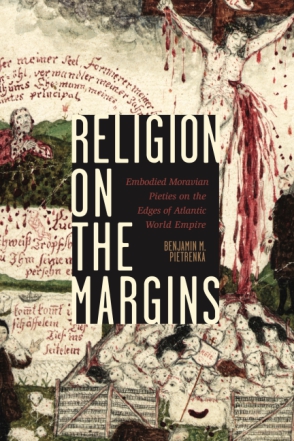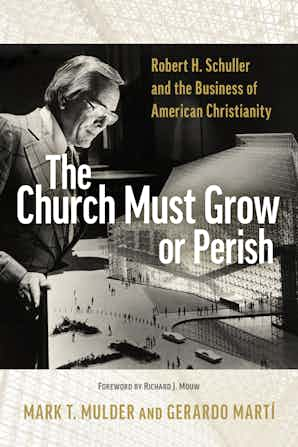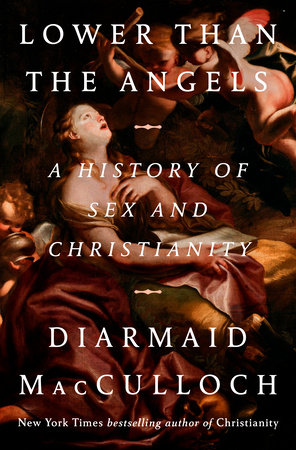Monthly Updates on Recent Books in the History of Christianity
To raise awareness of recent books in the history of Christianity, the editorial staff of Church History: Studies in Christianity and Culture highlights each month a list of 10-15 books in diverse periods and geographical regions that we hope will be of interest to our members. We include here below the 54th monthly list, chosen by our staff, with excerpts from the publishers’ blurbs.
Diarmaid MacCulloch, Lower than the Angels: A History of Sex and Christianity. 2025
Few matters produce more public interest and public anxiety than sex and religion. Much of the political contention and division in societies across the world centres on sexual topics, and one-third of the global population is Christian in background or outlook. The issue goes to the heart of present-day religion.
This book seeks to calm fears and encourage understanding through telling a three-thousand-year-long tale of Christians encountering sex, gender, and the family. The message of Lower than the Angels is simple, necessary and timely: to pay attention to the complexity and contradictions in the history of Christianity. The reader can decide from the story told here whether there is a single Christian theology of sex, or many contending voices in a symphony that is not at all complete. Oxford’s Emeritus Professor of the History of the Church introduces an epic of ordinary and extraordinary Christians trying to make sense of themselves and of humanity’s deepest desires, fears and hopes.

Robert J. Miller, Faith of the Fathers: The Comprehensive History of Catholic Chaplains in the Civil War. 2025
University of Notre Dame Press
Faith of the Fathers brings to light the forgotten stories of courageous chaplains whose commitments to faith and to men at war during America’s most divisive conflict have long been overlooked. The Reverend Robert J. Miller provides a comprehensive and compelling portrait of the 126 priest-chaplains who served during the Civil War and reflects on the importance of religion and faith in nineteenth-century America. As a culture of death and horror raged around them, Catholic priest-chaplains met the needs of soldiers and officers alike, providing years of faithful and dedicated service in hospitals, prisons, battlefields, and camps.
Whether ministering to Union or Confederate soldiers (or both), in eastern or western theaters, in battle or camp, these priests risked their lives to bring faith and hope to one of the darkest and most devastating periods of American history.


Marc Wolterbeek, ed. and trans. 'The Gods Have Faces': The Biblical Epigrams and Short Poems of Hildebert of Lavardin. 2024
Hildebert of Lavardin is one of the great poets of the Middle Ages, praised for his elegant style by his contemporaries and by modern scholars alike. He occupies a seminal position in the revival of learning in the late Middle Ages known as the Twelfth Century Renaissance, and his mastery of classical Latin style was so refined that some of his works were long considered products of Antiquity. This collection of Hildebert's biblical epigrams and short poems introduces English-speaking readers to the best works of this neglected poet and places them in the context of his life and literary career. The translations attempt to bring the reader as close as possible to experiencing these poems in their original Latin while still being readable and comprehensible, facilitated by notes and commentary. Hildebert's poetry is sometimes challenging, dense and complicated, yet his rhetoric is often beautiful, even magnificent.

Dimitris Kousouris, The Island of the Pope: Catholics in the Aegean Archipelago between Empire and Nation-State, 1770-1830. 2025
For the Aegean island of Syros, the Greek Revolution (1821-1832) marked a significant turning point. Known as “the island of the Pope”, due to its Catholic majority, Syros transformed into a major commercial hub, seemingly triggering the withdrawal of its indigenous Latin community. Juxtaposing the view from the Archipelago with that from Istanbul, the Peloponnese, Rome, Paris and Vienna, this volume revisits the island’s history. From early encounters between native inhabitants and groups from across the Ottoman Levant, to how the Latin community navigated conflict and change during the Greek War of Independence, this book offers new insights into the political, cultural and social history of the region.
Benjamin J. King, The Oxford Movement and the People of God: Enslavement, Education, and Empire. 2025
This book is about the role that ‘Tractarian’ theologians considered the lay people should have in the Church, which is to say it is a book about theology. But it is also about the role certain lay people did play in the Church of England, at home and overseas during the nineteenth century, and is therefore a history book, too. ‘Tractarians’ is a label which includes not only the writers of the Tracts for the Times—the leaders of what became known as the Oxford Movement—but also their readers and followers. The first chapter introduces these lesser-known laymen and laywomen, while estimating overall numbers of lay Tractarians. The next five chapters explore theological topics that determine the laity’s normative role (Providence, ecclesiology, consensus fidelium, episcopacy, and spirituality) in the view of Keble, Newman, Pusey, and other theologians. New here is the way each topic is paired with a historical theme (colonial slavery, Church Establishment, synods, the British Empire, and the American Civil War) to show the theological motivations for what the lay Tractarians were doing.

Mary Beth Swetnam, Contentious Unions: Black Baptist Schools and White Money in the Jim Crow South. 2025
In Contentious Unions: Black Baptist Schools and White Baptist Money in the Jim Crow South, Mary Beth Swetnam Mathews interweaves the stories of the founding and development of Richmond Theological Seminary (Virginia), Central City College (Macon, Georgia), and American Baptist Theological Seminary (Nashville, Tennessee)—colleges that saw challenges, complexities, and hard-won accomplishments in the Post-Reconstruction era. Her study begins just after the Civil War, when one of these institutions provided educational opportunities for newly freed slaves, and follows the fortunes of the schools through the 1960s.
Mathews reveals the financial, curricular, and identity struggles of schools that came into being and survived under difficult circumstances. The institutions relied on funding from White Baptists, but also had to fight against control and exploitation from those who helped them financially. Though each school evolved with a different identity and educational mission, Mathews concludes that “they could be simultaneously symbols of racial independence as well as victims of white supremacy.”
As “oppositional spaces,” these schools gave their communities access to the ground floor of the civil rights movement, and the author highlights their connections to some of the more famous activists such as John R. Lewis, Jo Ann Gibson Robinson, and Gordon P. Hancock. Ultimately, Mathews’s book is a fascinating and complex account that uses the history of these three institutions to illuminate the origins of the long struggle for civil rights.

Benjamin M. Pietrenka, Religion on the Margins: Embodied Moravian Pieties on the Edges of Atlantic World Empire. 2024
Pennsylvania State University Press
In the eighteenth century, missionaries of the radical, Pietist Moravian Church wandered from Germanic Europe to the edges of the known world in search of tolerance and a closer relationship to God. This open-minded, cosmopolitan undertaking led to unintended consequences, however, both for the Moravians and for the other persecuted peoples—European, African, and Indigenous—they sought to convert.
Religion on the Margins examines the complexities of early modern Moravians as a cosmopolitan community focused on an eschatological global vision while having to negotiate diverse cultures and, most importantly, the institution of slavery. Drawing on a transatlantic archive of letters, diaries, teachings, and mission histories, Benjamin M. Pietrenka sheds light on how a professedly anti-colonial cast of characters became entangled in the complex realities of European colonialism in the Atlantic world. Ultimately, Pietrenka shows how the Moravians, operating from within the constraints of mission work, became complicit in the European imperial project in spite of their stated values and their own experience of marginalization.
For scholars of early modern religion, empire, and politics, Pietrenka’s book challenges tendencies in the field to equate modernity with secularization and invites us to consider how nonelite actors understood religion and ethnicity through each other, in ways that contributed to the emergence of modern scientific racism and white supremacy.

Mark T. Mulder and Gerardo Martí, The Church Most Grow or Perish: Robert H. Schuller and the Business of American Christianity. 2025
The Church Must Grow or Perish: Robert H. Schuller and the Business of American Christianity examines Schuller’s indelible imprint on the American church, and how he developed a model of ministry—both lauded and critiqued—that transformed Christian life and community across this country. Schuller’s story is the starting point for powerful trends that continue to shape much of American religion today: televangelism, seeker-sensitive outreach, megachurches, the suburbanization of white Christianity, pastoral entrepreneurship, and market-oriented Christianity in pursuit of growth.
Authors Mark T. Mulder and Gerardo Martí explore Schuller’s drive to develop a theology, a persona, and a set of practices that he believed were necessary to keep Christianity vibrant long into the future. They trace Schuller’s career arc from his beginnings as an Iowa farm boy to his years as a charismatic Southern California preacher—one who believed that in order for the church to thrive, pastoral leaders needed to borrow from the best practices of big business, including the entertainment industry. This fascinating biography is essential reading for those who want to fully understand a transformative force in American Christianity.
Brian J. Miller, Sanctifying Suburbia: How the Suburbs Became the Promised Land for American Evangelicals. 2025
The suburbs are home to the majority of Americans, including millions of evangelical Christians and thousands of evangelical congregations and organizations. And while American evangelicals are a potent force in society and politics, their connection to and embrace of the suburbs are rarely examined. How did white evangelicals come to see the suburbs as a promised land, home to the evangelical good life and to dense concentrations and networks of evangelical residents, churches big and small, and nonprofit organizations? This book systematically assesses how evangelicals became intertwined with the suburbs and what this means for evangelical life.
Brian Miller shows how evangelical views of race and ethnicity, social class, and gender led to anti-urban sentiment, white flight, and the pursuit of racial exclusivity-all of which has led evangelicals to make the suburbs their physical and spiritual home. At the same time, clusters of evangelical organizations were planting themselves in the suburbs, drawing evangelicals out of the cities. Through sociological analysis, case studies of multiple communities with clusters of evangelical residents, and examinations of evangelical culture, Miller shows that in order to fully understand American evangelicals we must take a deeper look at how evangelicals embraced suburbs and how the suburbs shaped them.
Alexander Marx, The Preaching of the Third Crusade (1187–1192): The Early University of Paris, Biblical Exegesis, and the Coming Apocalypse. 2025
This book delivers the first substantial study of the preaching of the Third Crusade (1187-92). It assembles c.200 sermon texts and c.100 manuscripts, to understand the explosive dynamic of mobilization in the Latin West. Dealing with the essential fact that a genre called ‘crusade sermon’ did not exist, it develops methodological devices for identifying sermons relevant for the crusading purpose. The book contests thus the modern historiography, which has placed too much trust in the few chronicle reports. However, its fruitful blending of crusading, preaching, exegesis, manuscript studies, and intellectual history has much to offer beyond crusade studies.
Finally, for staying up-to-date on the latest titles in all fields, we recommend regularly perusing New Books Network and its "New Books in Christian Studies” page. These pages are updated regularly.

